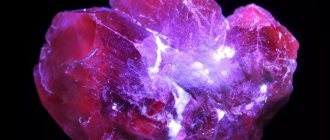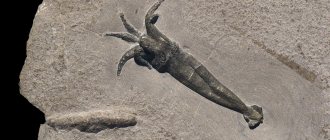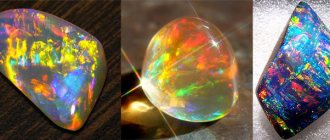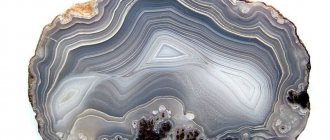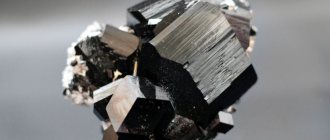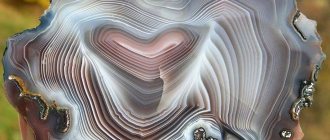A meteorite stone that flies to Earth from outer space has a large number of magical properties. It has a positive effect on a person’s aura, taking away negative energy and saturating it with positive energy vibrations. The mineral is able to protect the owner from bad influences, bad thoughts and actions. The stone makes a person wiser, and also reveals talents and intuition in him.
There are 3 types of meteorites: iron, stone and mixed. The most valuable among them in terms of benefits are the latter.
History and origin
Pallasites represent one of two classes of stony-iron meteorites. According to scientists' research, such meteorites are contemporaries of the formation of the planets of the solar system, formed from the fragments of colliding celestial bodies. The average age of pallasites is determined to be 4.5 billion years.
Meteorite – Pallasite
The scientific study of fallen celestial bodies dates back to 1749, when a mining master named I.K. Mettikh learned about the discovery of a block of stone by the blacksmith Yakov Medvedev. The unusual object is located on the territory of the Krasnoyarsk Territory, 200 km southwest of the city of Krasnoyarsk, not far from the village of Medvedevo, where it was subsequently dragged by the discoverer. It was the first extraterrestrial visitor of iron-stone origin found, as well as the first meteorite to land in Russian open spaces. However, scientific proof of the origin of the find will appear only after almost half a century.
The study of the cosmic body began only 23 years later. In 1772, an expedition of a German scientist who was in Russian service, Peter Simon Pallas, took place on the lands of the Krasnoyarsk Territory. Following a written notification from Mettich, who described in detail what he saw, the academician inspected the mountain on which the stone was found. In 1773, a block weighing 40 pounds (the total weight of the meteorite was 42 pounds or 687 kg), by order of Pallas, was taken from the blacksmith’s yard, where it had been located all this time, to St. Petersburg for study. The stone was described as native iron. In 1777, the sample under study was moved to the Kunstkamera.
This is interesting! In 1794, the book of the German physicist and meteorite researcher Ernest Florence Friedrich Chladni, “On the Found Iron Mass, on Other Similar Masses, and on Certain Natural Phenomena Associated with It,” was published. This work became the first scientific substantiation of the extraterrestrial origin of the find, laying the foundation for the development of meteoritics - the science of meteorites, as well as cosmic dust that reaches planet Earth. Ernest Chladni named the meteorite “Pallas Iron” in honor of the academician who studied the find, after which the term “pallasite” was applied to all stony iron meteorites of this class.
Beginning in 1976, for three years of the expedition of A.I. Eremeeva determined the exact coordinates of the fall of the cosmic body. This is the right bank of the Krasnoyarsk reservoir, 4.5 km southeast of Bolshoi Emir Mountain.
Also read: Calcite - an amulet for all occasions
LiveEphemeris
Stone meteorites
The Chelyabinsk meteorite is an ordinary chondrite, which contains metallic iron, olivine and sulfites, and also contains a melting crust. Received the name Chebarkul.
The meteorite raised from the bottom of Lake Chebarkul will be examined and then transferred for storage to the Chelyabinsk Regional Museum of Local Lore. The lifting of the celestial body from the water will be carried out from Yekaterinburg. Divers managed to calculate the coordinates of the place where the meteorite is located and its approximate dimensions. The meteorite, measuring 50x90 centimeters, is located at a depth of nine meters.
The Chelyabinsk meteorite is a chondrite. Carbonaceous chondrites are “loose” meteorites of silicate composition, part of the core of icy comets. The Tunguska meteorite was just such a comet - a giant ball of dirty ice with dust and stones. The destruction of a celestial body over Nevada and California in 2012, the Chelyabinsk meteorite are phenomena of the same order.
“The Chelyabinsk meteorite became an almost complete copy of the Tunguska meteorite and largely explained its phenomenon to scientists,” said Vitaly Romeiko, Moscow astronomer, head. Zvenigorod Observatory, leader of 24 Tunguska expeditions. - The analogy is direct. In both cases, the explosion occurred several kilometers above the Earth’s surface. Both celestial bodies flew at the same time of day - early in the morning. Both of them ended up in the same geographical region - Siberia. The whole complex of atmospheric phenomena - the passage of a superbolide, the glow of which was brighter than the sun, the white condensation trail in the sky, the hissing and crackling that accompanied the fall - the picture of the explosion matches the description very well.
Kunashak is a stone chondrite meteorite with a total weight of 200 kg (about 20 fragments) that fell on July 11, 1949 in the Kunashaksky district of the Chelyabinsk region. It was named after the village of Kunashak, the regional center of the Chelyabinsk region, near which it was found.
Pervomaisky meteorite. A chondrite meteorite weighing 49,000 grams fell on December 26, 1933 in the Yuryev-Polsky district of the Ivanovo region, in the Pervomaisky village. “According to eyewitnesses, at six o’clock in the evening on December 26, 1933, a huge, moon-sized, extremely dazzling fireball with lightning speed swept across the sky from southeast to northwest across almost the entire Ivanovo region, scattered behind the Yuryev-Polsky fireworks cascade sparks and went out, erupting for tens of kilometers around with thunderclaps and a long-lasting roar. Glass rattled, huts shook, panic seized the population...” L.A. Kulik, 1934
Part of the Mill Sutter meteorite weighing 17.7 grams. “A bright fireball moving from east to west was seen on April 22, 2012 in California and Nevada at 7:51 a.m. local daylight time. Mille Sutter is an unusual type of carbonaceous chondrite.
Chinese tektite, 1905 Tektites arise as a result of the melting of the earth's crust during a powerful meteorite impact, and then scatter from the crater over long distances
Stone meteorite Pultusk, type - Chondrite H5. Weight 11 gr. The fall occurred on January 30, 1868 at 7:00 pm near the town of Pułtusk, approximately 60 kilometers northeast of Warsaw. Thousands of people witnessed the impact of a large fireball followed by detonation and a shower of small debris falling onto ice, ground and houses over an area of about 127 sq km. The estimated number of fragments was 68,780. The total mass of the meteorites was 8863 kg. The vast majority of the fragments were small, (a few grams), now known as Pultusk peas.
Mining locations
Russian Siberia is rich in specimens of pallasite. It was there that the first pallasite was found. In addition, the Magadan region is famous for its finds. Large blocks were found in China and the USA. Sweden, Argentina, the Atacama Desert and even Antarctica are rich in rocks from space. Often pallasites are found completely by accident, regardless of archaeological or paleontological excavations, for example, during construction or work to strengthen the banks. In total, 55 specimens of pallasite have been found on Earth in different parts of the planet.
The most famous meteorites
The most famous meteorites
The most famous meteorites
The most famous meteorites
The most famous meteorites
Among the meteorites, it is worth noting the most famous:
- Goba - has the heaviest weight (60 tons) among all discovered meteorites, fell to Earth in 1920, in Namibia;
- Gansedo - was found in September 2016, is the second largest, weighing 30.8 tons;
- Allende is the largest carbonaceous meteorite that was discovered on Earth;
- Lebanon is the largest meteorite discovered on Mars.
Physical properties
The basis of pallasites is iron and nickel, which make up a kind of network that contains the silicate component of the meteorite - olivine crystals. The cosmic mineral is transparent and consists of magnesium, iron and silicon. But it was not possible to create such an alloy under terrestrial conditions.
Compound:
- Metals - iron (80-90%),
- Nickel (3-20%),
- Olivine inclusions.
The parent body of pallasites is differentiated asteroids. If iron meteorites originate deep in the asteroid core, then iron-stone bodies are part of its inner coating - the place where metal and the silicate crust of the asteroid are mixed. Pyroxene pallasites stand apart - meteorites, the iron-nickel network of which includes not only olivine, but also pyroxene crystals. The mystery of the origin of such meteorites has not yet been revealed.
Chemical composition
The basis of the composition is meteorite iron of the nickel type. The proportion of these two metals in the alloy is not the same and may vary. The sections of the samples have a beautiful pattern. It is represented by shiny stripes that intersect with each other. The structure also includes ribbons and polygonal platforms.
The material contains an unnaturally high iridium content. Another feature is the presence of uneven scatterings of olivine inclusions in the samples. Debris present in the impact area may consist only of metal or contain olivine inclusions.
Famous representatives of the Pallasites
The end of the 19th and beginning of the 20th centuries was marked by two impressive finds of pallasites. One of the stones is considered the property of Russia.
Fukan
In 2000, an American tourist traveling through Chinese lands discovered an extraterrestrial nugget that weighed more than a ton. He sent the sawed-off fragment of the mineral home. Research has shown that this stone originated on an ancient planet, and its age is comparable to the age of the Earth. The peculiarity of the Chinese specimen is its fairly large olivine crystals, constituting 50% of the total mass of the meteorite.
Today, almost half of the stone is owned by the Natural History Museum of America. A small part of the celestial body (31 kg) is stored at the Arizona State University Meteorite Laboratory. This pallasite bears the name of the Chinese city of the same name where it was discovered - Fukan.
Seymchan
Since 2009, the Seymchan meteorite has been classified as a pallasite. The first part of this extraterrestrial body was discovered by geologist F.A. Mednikov during an expedition in the summer of 1967. A triangular conglomerate weighing 272 kg is located among stones on the bank of the Yasachnaya River bed (Magadan region, near the village of Seymchan). Three months later, in October of the same year, mine detector I.Kh. Markov came across a second sample, weighing 51 kg. The specimen was located only 20 meters from the site of the first discovery.
This is interesting! Some Seymchan samples are notable for the presence of Widmanstätten patterns, better known as Thomson structures. These are figured patterns formed by long nickel-iron crystals. The bent outlines of the figures indicate that during its entry into the Earth's atmosphere, the meteorite was subjected to strong resistance, which caused a shift and destruction of the celestial body into pieces.
The last expedition was led by geologist and meteorite enthusiast Dmitry Kachalin in 2004. Thus, another 50 kg of new samples were found, of which 10 kg contained olivine crystals. Thanks to new finds, the Seymchan meteorite was classified as a pallasite, although previously it was not possible to detect the silicate nature of the samples, and the meteorite was considered an octahedrite.
Also read: Unakite is a unique relative of granite
What happens when meteorites fall to Earth
A trace from a meteorite fall in Chelyabinsk
Almost all cosmic bodies have a high speed of movement (when entering the atmosphere it can reach 72 km/s). The ignition and glow of a meteorite occurs due to its friction with the air. In most cases, such solids burn completely before they collide with the Earth's surface. If the meteorite is large in size, then its movement gradually slows down, and it itself cools down. Further developments will depend on the initial developed speed, body mass and the angle of entry into the atmosphere.
If the meteorite can slow down, its trajectory will change and it will simply fall.
Sometimes the structure of an object is so heterogeneous that it simply explodes during flight, and only its fragments reach the Earth. This phenomenon is called "Meteor Shower". If the speed of the body does not decrease, and its size is large enough, a large explosion occurs when it collides with the surface of the planet. A deep crater appears at this place. Such astroblemes are not always visible on Earth, because they are destroyed by geological processes. Interesting fact : on other planets you can clearly see traces of falling meteorites of various sizes.
Areas of application
The heterogeneous structure of pallasite causes different values of its individual parts. Found meteorites are used for the following purposes:
- Scientific research.
- Jewelry processing.
- Crafts.
- Collectibles.
Pallasite is of greatest value for science. The study of cosmic bodies makes it possible to expand knowledge about the origin of our planet and the entire solar system as a whole.
Pallasite is successfully used by craftsmen to create decorative items, cases and boxes for storing jewelry. Jewelers are interested in the mineralogical part of the meteorite – olivine. Freed from metal inclusions, the faceted stone looks amazing in jewelry.
Rarity hunters love pallasite just as much as scientists or jewelers. Specimens found on all continents of the planet make up an impressive collection that can please the eye or bring a decent fortune.
How does a meteorite differ from a meteor, fireball, comet and asteroid?
Photo of comet NEOWISE
Often a meteorite can be mistakenly called a fireball, meteor or asteroid. To understand the classification of cosmic bodies, you need to study their characteristics.
- Meteorites are celestial bodies that were able to overcome the planet’s atmosphere and fall to its surface.
- Meteors are small fragments of cosmic bodies, not exceeding a few centimeters in size. These particles enter the atmosphere at high speed and burn brightly, simulating a shooting star.
- A bolide is a fairly bright meteor. Behind such a fireball you can see a trail of smoke. The flight of a cosmic body is accompanied by loud noise and often ends with an explosion.
- Comets are bodies made of ice and gas that orbit the Sun. When a comet approaches the Sun, it develops a tail, often reaching millions of kilometers in length.
- Asteroids are other inert cosmic bodies made of stone. Most of their orbits are located between Mars and Jupiter, and their outer belt is beyond the orbit of Pluto.
Types of stone
Depending on the chemical composition, pallasites are divided into three groups:
- The core group makes up the majority of the specimens found and is notable for its similarity to some iron meteorites, suggesting a common formation. Nickel content ranges from 8-12%.
- “Eagle” pallasites are similar to iron meteorites of another group, containing from 14 to 16% nickel.
- Pyroxene pallasites are unique meteorites that contain pyroxene crystals together with olivine.
The Seymchan meteorite is considered an anomalous pallasite, as it contains a large amount of iridium. In addition, not all fragments of this celestial body include olivine crystals.
Parent bodies of meteorites
Widmanstätten figures on a section of a meteorite
After studying the chemical and other compositions of meteorites, scientists concluded that they are fragments of large objects in the Solar System. The radius of such parent bodies is approximately 200 km. The largest asteroids are approximately this size. The result of the analysis is based on the cooling time of the iron meteorite, where several alloys with nickel are obtained, forming Widmanstätten figures.
The implication is that the rocky meteorites were dislodged from small planets that have no atmosphere and are covered with craters, much like the Moon. However, it is worth noting that meteorites and samples of the earth’s satellite differ significantly in their chemical composition. From this we can conclude that meteorites did not come specifically from the Moon.
Interesting fact : based on the analysis of photographs of the flight of meteorites, scientists concluded that they came from the asteroid belt.
Healing and magical properties
Stories spanning decades tell of both the beneficial and harmful effects of meteorite rocks. According to some reports, space guests cause internal discomfort or headaches. Other stories talk about the use of pallasites to treat skin diseases - purulent wounds, bedsores, warts, birthmarks, erysipelas. In addition, water or herbal decoctions were infused on meteorites, which were given to mothers and children. According to legends, such a ritual prolongs life. From a scientific point of view, the healing abilities of iron and iron-stone meteorites are explained by the presence of a magnetic field that helps a person overcome ailments.
Parapsychologists consider meteorites to be an activator of human paranormal abilities. Heavenly stones are also credited with the properties of a talisman against misfortune. For women, a pendant with a cosmic nugget will protect against celibacy, and any meteorite pebble is considered a magnet for attracting the opposite sex.
Also read: Dolomite - a natural unusual stone
Jewelry with stone
Jewelry made from meteorites constitute a separate group of products from jewelry houses. The price for such accessories is not astronomical, but also not publicly available:
- Pendant in 925 silver with a polished triangular sample of the Seymchan meteorite – 34,000 rubles.
Pendant with Pallasite - Men's ring made of solid pallasite from Swedish lands, framed in silver – 50,000 rubles.
- Silver earrings made from a single piece of the Seymchan meteorite – 45,000 rubles.
Earrings
Costume jewelry has a lower price than products made from precious metals.
How to spot a fake
Pallasite is a stony-iron meteorite, which means its first distinguishing property will be the presence of a magnetic field. This can be determined using a magnet brought to the fragment. In addition, when passing through the earth's atmosphere, the edges of meteorites or their fragments melt, and on the very surface of the space rock there are characteristic dents, similar to fingerprints or burst bubbles.
Some pallasites (Seymchan) are endowed with Widmanstätten patterns, which cannot be recreated under terrestrial conditions. They also have not yet learned how to smelt cosmic olivine. In addition, any purchased meteorite or jewelry made from it must be supplied with an appropriate geological document confirming its cosmic origin and authenticity.
External signs
A meteorite with a pronounced melting crust.
Among the main external features of a meteorite it is worth noting:
- melting crust;
- regmaglypts;
- magnetism.
Additionally, these cosmic bodies have an irregular shape. It is quite difficult to encounter a round or cone-shaped meteorite. The surface is a molten and re-solidified layer of meteorite material. This process occurs as it moves through the atmosphere, where it heats up to a temperature of approximately 1800 degrees.
The depressions that characterize the surface of a meteorite are called regmaglypts. They arise as a result of ablative processes during the movement of a body through the atmosphere. Absolutely all meteorites have magnetic properties.
How to wear and care
Products made from meteorite iron were worn by the ancient Egyptians. Modern products are distinguished by their brevity. Each of the decorations will be one of a kind, which will already make the image unique. The variety of designs allows you to wear pallasite accessories with any style of clothing, from a casual business suit to an evening outfit.
A stone that has traveled billions of space kilometers does not require special care. However, specimens with olivine require careful handling. Such samples are stored separately, from time to time cleaning the stones under running warm water.
Where is it used?
“Pallas iron” has found application as a collection material. Both purely metallic material and samples with olivines of different shades are suitable as exhibits.
Polished Pallasite meteorite
The stones are also used to make jewelry.
Any fragment of pallasite, especially a ball or other product, is suitable as a status gift.
The stone that overcomes the cosmic abyss is strong. But you need to take care of it. Especially behind the crystal inclusions. They are given a separate box, and the dirt is washed off with warm water.
Interesting Facts
- The largest pallasite was found in the United States in 1882. The international name of the stone is Brenham. The giant space guest weighs 4.3 tons.
- In 2002, pallasite weighing 227 kg was discovered on Belarusian lands (Gomel region). The extraterrestrial alien lay at a depth of three meters, so the discovery was accidental. The stone was discovered by builders while digging a pit.
- Another remarkable pallasite weighing 1.5 tons was found on an Australian cattle farm in 1937.
- In honor of academician P.S. Pallas in the 19th century founded the city of Pallasovka, which belongs to the Volgograd region. In 1990, another sample of pallasite was found in this area, weighing almost 200 kg.
- Omolon is considered the oldest pallasite. Its age is estimated by scientists at 5.7 billion years. This cosmic miracle is the pride of Kolyma and is kept in the Natural History Museum of Magadan.
Large meteorite craters
Large meteorite craters
Large meteorite craters
Large meteorite craters
Large meteorite craters
Large meteorite craters
Large meteorite craters
Among all the traces left by meteorites on Earth there are giant craters, namely:
- Vredefort (South America) is the largest crater with a diameter of at least 300 km;
- Manicouagan – 100 km;
- Popigai (Russia) – 100 km;
- Acraman (Australia) – 90 km;
- Pingualuit (Canada) – 3.4 km;
- Arizona Crater (USA) – 1.2 km.
Interesting: Venus - description, structure, characteristics of the planet, interesting facts, photos and videos

